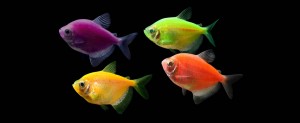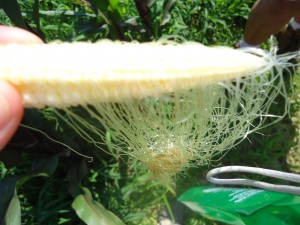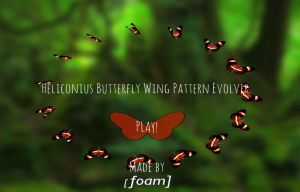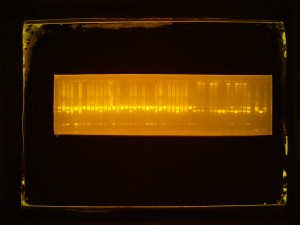We both decided to get Glofish for our classroom. I am particularly partial to the fluorescent yellow ones: )
Monthly Archives: July 2014
Aha Moment
Curriculum! Externship Experience!
Curriculum! Externship experience! How can I share the experience with my students? How can I relate the experience so that they are filled with the same curiosity that I am? I can’t. It is just not possible to take graduate level work and push it into my 8th grade lesson.
However, I can model the experience that I have had. The most rewarding part of my externship was just exploring and learning about all the different applications of genetically modified organisms (GMOs), the research being done in labs, and social science surrounding biotechnology.
I want my curriculum to give my students an opportunity to investigate and to understand using the information that they gather from readings, video clips, and group discussions. Then I want to give the students time to discuss new biotechnology topics with peers. I also want to provide a lab experience so the students can model part of the process used to create transgenic organisms. Finally, I want to provide a podcast to reinforce the basic knowledge needed to understand each of the learning objectives for the lesson. I think the combination of giving the students an opportunity to explore several applications of biotechnology and then reinforcing the baseline objectives will help them be confident learners.
This week I was excited to attend a great program at NCSU. A last minute administrative issue canned that plan. But it opened an even more awesome opportunity to attend the NCSU Crop Research Center workshop. The workshop turned out to be a great way to get ideas for my lesson. The workshop today made me realize that my Kenan lesson plan is a work in progress and I think it will evolve as I take advantage of workshops and seminars about GMOs. Below are some pictures of corn hybrids being researched at the center. They were created using a seed bank. This particular selection of seeds (known as a heritage selection) came from all the corn planted in a field in western Carolina about one hundred years ago. At the time, no selection was done by the farmer.
Where do you begin when you have an options buffet?
July 12, 2014
As I have been reflecting about what I will bring back to my class, I have thought about possible options from Dr. Gould’s genetics lab. Dr. Gould’s lab and their work on transgenic crops and insects directly connects to my units on evolution, biotechnology, and microbiology.
Maybe a better question to ask is: how can I plan a schizophrenic unit? Not really possible when I am hoping to also give my students a thoughtful lesson that builds on their current science understanding and provides a platform for their high school science. So I went back to the standards and wrote the SWBAT statements. I have started to reduce my buffet to a plate size proportion that will primarily focus on biotechnology and its impact on society.
The videos I put together with collaborating scientists will come in handy here. I will offer them as an enrichment piece for my students. Here is an example of one of the videos. This video can be used as a lesson about malaria. I was going to use this as a flipped classroom option for my students.
Dr. Kuzma and GES at NCSU
July 7-12, 2014
Based on your experiences, what are the greatest challenges for leveraging technology to empower learning in your classroom and school?
July 5, 2014
I think the biggest challenge for leveraging technology in our school is access to computers. We have one computer cart that is shared by five teachers. When I do use the computer cart with my students, I plan assignments/projects that can be completed during a class time. I am torn about having students use their phones or tablets during class since I feel it divides my class into the haves and the have nots. As a result, I use students’ personal technology devises sparingly.
The other challenges I have for leveraging technology to empower my students’ learning, is my students’ access to the internet. For students to collaborate using Google docs or presentations, they need to have internet access at home. One of the neighborhoods that is part of our school has a community center that opens a computer lab in the evenings for students to complete their homework. Although this is a wonderful program, I am concerned about my students walking home in the dark. As a result, I provide a variety of project choices that include both technology and non-technology options so that all my students can complete their assignments.
My students’ access to technology impacts the ease with which they can get answers. I find that my students that do not have the access to computers and internet access at home are also students that are struggling to complete their homework on time. I provide morning and after school support for these students. However, this is a poor substitute for having full access at home.
Great Week in Dr. Gould’s and Dr. Lorenzen’s Lab
Monday June 30 – July 3, 2014
|
Earlier this week, I visited Dr. Marcé Lorenzen’s lab and watched Clay Chu insert DNA into beetle embryos. Follow the video link on the right to see him explain how transgenic beetles are made. Clay also explains the importance of his research on wild type species for which we have very little genome knowledge. I learned an interesting fact about his work: only 2% of the embryos that have DNA inserted will develop into adult beetles. Clay’s research will take a great deal of time and patience to complete. |
Dr. Lorenzen’s Lab NCSU 2014 – DNA Insertion
|
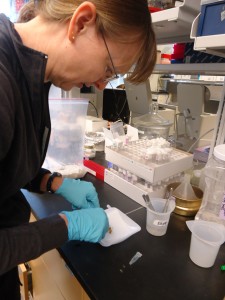
Later on in the afternoon, I returned to Dr. Gould’s Lab to help Emma with a DNA extraction. I enjoyed this work after reading related articles and listening to a visiting professor’s presentation. It allowed me time to think and reflect on what I was learning. Another fun find that a visiting researcher shared with us this week: Thanks to Jen Baltzegar, a graduate student in Dr Gould’s lab, I was able to extract DNA, amplify the DNA using PCR, and then run a gel on the samples to view the results. This was a two day process of separating the DNA and preparing samples for the PCR and gel electrophoresis. After taking a picture of the gel, Jen reviewed the image carefully marking specific areas of the gel as positive or negative for a particular region of DNA. This information was used to continue certain moth breeding lines that are currently being researched. The time and commitment necessary to maintain a breeding facility and document the DNA samples from the crosses being done was admirable. I simply could not appreciate the process before working in Dr. Gould’s lab.
|
|
I had a wonderful conversation with Dr. Gould and I was even able to catch him on Video. I asked him to talk about why he went into research and how students can get involved in research. The video clip link is posted below. Dr. Fred Gould Becoming a research Scientist YouTube link: http://youtu.be/5y8o6iirTrw |
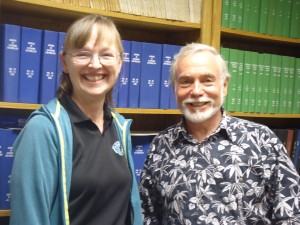 |
